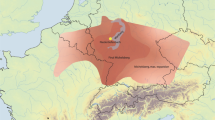Summary
A Samoyed-speaking group of fishers, hunters, and deer breeders numbering 1500 in total has been investigated. Seven territorial subgroups were examined with respect to 15 genetic systems. The presence of A2, cde, CwDe, Kpa, AK2, pc, Gmfb, and Gmfnb genes or haplotypes in low or moderate frequencies was observed. An unexpected finding was a deleted Gm(-;n;gb) phenotype in three siblings.
Significant local genetic heterogeneity was observed with regard to AB0, Rh, Tf, PGM1, 6-PGD, and Gm systems. The summed genic heterogeneity was found to be highly significant (χ 2132 =663.70, P< 0.001). Mean Fst was equal to 0.0228, reflecting variation among subpopulations dispersed in the forest-tundra area and living under conditions of partial isolation.
Similar content being viewed by others
References
Abanina TA, Sukernik RI (1980) Population structure of forest Nentzi. II. Studies on genealogy. Genetika 16:156–164 [in Russian]
Alexeev VP (1971) Forest Nentzi: somatologic observations. Vopr Antropol 39:61–63 [in Russian]
Castren MA (1856) Reiseberichte und Brief aus den Jahren 1845–1849. St-Petersburgh, S 68
Loghem E van, Sukernik RI, Osipova LP, Zegers BJM, Matsumoto H, Lange Gerda de, Lefranc G (1980) Gene deletion and gene duplication within the cluster of human heavy chain genes. Selective absence of IgG subclasses. J Immunogenet 7:285–299
Osipova LP, Sukernik RI (1979) Possible homozygous deletion of a gene coding the constant region of heavy chains of immunoglobulin G1 in three siblings. Dokl Akad Nauk SSSR 249:987–989 [in Russian]
Reed TE, Schull WJ (1968) A general maximum likelihood estimation program. Am J Hum Genet 20:579–580
Sukernik RI, Abanina TA, Karaphet TM, Osipova LP (1979) Population structure of forest Nentzi. I. Distribution of blood groups in six subpopulations. Genetika 15:327–332 [in Russian]
Verbov GD (1936) Forest Nentzi. Sov Etnografiya 2:57–70 [in Russian]
Workman PL, Niswander JD (1970) Population studies on southwestern Indian tribes. II. Local genetic differentiation in the Papago. Am J Hum Genet 22:24–49
Wright S (1951) The genetical structure of populations. Ann Eugen 15:323–354
Wright S (1965) The interpretation of population structure by F statistics with special regard to systems of matings. Evolution 19:395–420
Author information
Authors and Affiliations
Rights and permissions
About this article
Cite this article
Sukernik, R.I., Osipova, L.P., Karaphet, T.M. et al. Studies on blood groups and other genetic markers in forest Nentzi: Variation among the subpopulations. Hum Genet 55, 397–404 (1980). https://doi.org/10.1007/BF00290224
Received:
Issue Date:
DOI: https://doi.org/10.1007/BF00290224




